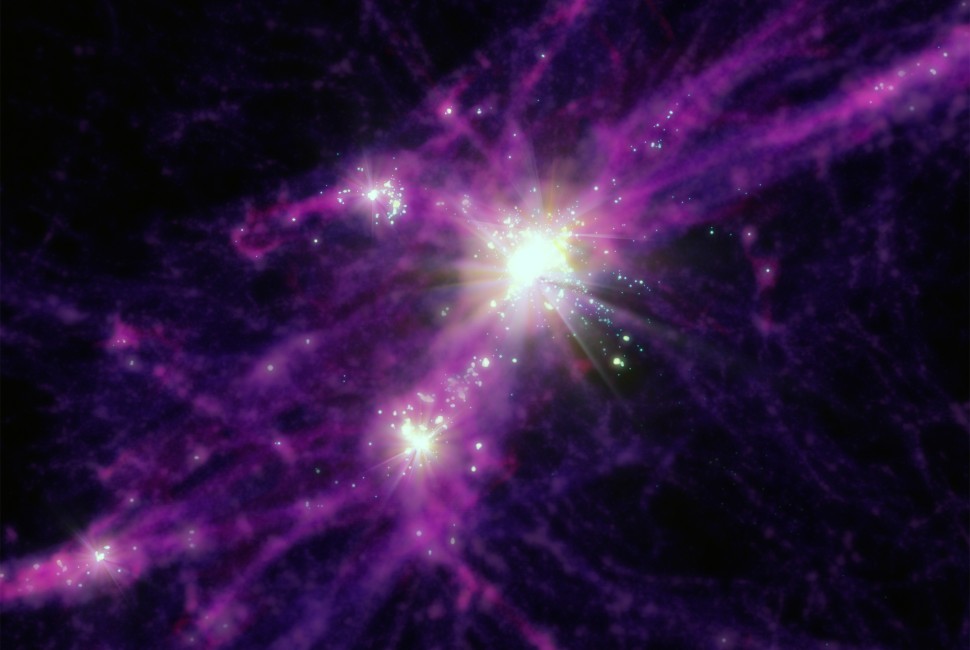
Intense flashes of light, not mass, resolve the puzzle of impossible brightness. When scientists viewed the James Webb Space Telescope’s (JWST) first images of the universe’s earliest galaxies, they were shocked. The young galaxies appeared too bright, too massive and too mature to have formed so soon after the Big Bang. It would be like an infant growing into an adult within just a couple years.
The startling discovery even caused some physicists to question the standard model of cosmology, wondering whether or not it should be upended.
Using new simulations, a Northwestern University-led team of astrophysicists now has discovered that these galaxies likely are not so massive after all. Although a galaxy’s brightness is typically determined by its mass, the new findings suggest that less massive galaxies can glow just as brightly from irregular, brilliant bursts of star formation.
Not only does this finding explain why young galaxies appear deceptively massive, it also fits within the standard model of cosmology.
The research will be published on Tuesday (Oct. 3) in the Astrophysical Journal Letters.
“The discovery of these galaxies was a big surprise because they were substantially brighter than anticipated,” said Northwestern’s, Claude-André Faucher-Giguère, the study’s senior author. “Typically, a galaxy is bright because it’s big. But because these galaxies formed at cosmic dawn, not enough time has passed since the Big Bang. How could these massive galaxies assemble so quickly? Our simulations show that galaxies have no problem forming this brightness by cosmic dawn.”
“The key is to reproduce a sufficient amount of light in a system within a short amount of time,” added Guochao Sun, who led the study. “That can happen either because the system is really massive or because it has the ability to produce a lot of light quickly. In the latter case, a system doesn’t need to be that massive. If star formation happens in bursts, it will emit flashes of light. That is why we see several very bright galaxies.”
Faucher-Giguère is an associate professor of physics and astronomy at Northwestern’s Weinberg College of Arts and Sciences and a member of the Center for Interdisciplinary Exploration and Research in Astrophysics(CIERA). Sun is a CIERA Postdoctoral Fellow at Northwestern.
A period that lasted from roughly 100 million years to 1 billion years after the Big Bang, cosmic dawn is marked by the formation of the universe’s first stars and galaxies. Before the JWST launched into space, astronomers knew very little about this ancient time period.
“The JWST brought us a lot of knowledge about cosmic dawn,” Sun said. “Prior to JWST, most of our knowledge about the early universe was speculation based on data from very few sources. With the huge increase in observing power, we can see physical details about the galaxies and use that solid observational evidence to study the physics to understand what’s happening.”
In the new study, Sun, Faucher-Giguère and their team used advanced computer simulations to model how galaxies formed right after the Big Bang. The simulations produced cosmic dawn galaxies that were just as bright as those observed by the JWST. The simulations are part of the Feedback of Relativistic Environments(FIRE) project, which Faucher-Giguère co-founded with collaborators at the California Institute of Technology, Princeton University and the University of California at San Diego. The new study includes collaborators from the Flatiron Institute’s Center for Computational Astrophysics, Massachusetts Institute of Technology and University of California, Davis.
The FIRE simulations combine astrophysical theory and advanced algorithms to model galaxy formation. The models enable researchers to probe how galaxies form, grow and change shape, while accounting for energy, mass, momentum and chemical elements returned from stars.
When Sun, Faucher-Giguère and their team ran the simulations to model early galaxies formed at cosmic dawn, they discovered that stars formed in bursts – a concept known as “bursty star formation.” In massive galaxies like the Milky Way, stars form at a steady rate, with the numbers of stars gradually increasing over time. But so-called bursty star formation occurs when stars form in an alternating pattern – many stars at once, followed by millions of years of very few new stars and then many stars again.
“Bursty star formation is especially common in low-mass galaxies,” Faucher-Giguère said. “The details of why this happens are still the subject of ongoing research. But what we think happens is that a burst of stars form, then a few million years later, those stars explode as supernovae. The gas gets kicked out and then falls back in to form new stars, driving the cycle of star formation. But when galaxies get massive enough, they have much stronger gravity. When supernovae explode, they are not strong enough to eject gas from the system. The gravity holds the galaxy together and brings it into a steady state.”
The simulations also were able to produce the same abundance of bright galaxies as the JWST revealed. In other words, the number of bright galaxies predicted by simulations matches the number of observed bright galaxies.
Although other astrophysicists have hypothesized that bursty star formation could be responsible for the unusual brightness of galaxies at cosmic dawn, the Northwestern researchers are the first to use detailed computer simulations to prove it is possible. And they were able to do so without adding new factors that are unaligned with our standard model of the universe.
“Most of the light in a galaxy comes from the most massive stars,” Faucher-Giguère said. “Because more massive stars burn at a higher speed, they are shorter lived. They rapidly use up their fuel in nuclear reactions. So, the brightness of a galaxy is more directly related to how many stars it has formed in the last few million years than the mass of the galaxy as a whole.” https://news.northwestern.edu/stories/2023/09/bursts-of-star-formation-explain-mysterious-brightness-at-cosmic-dawn/









Recent Comments